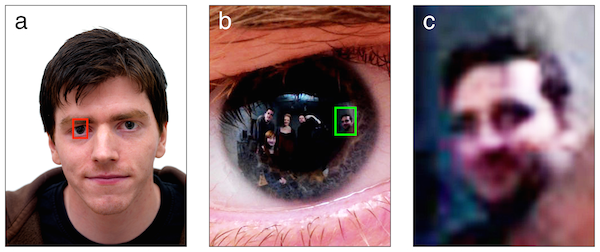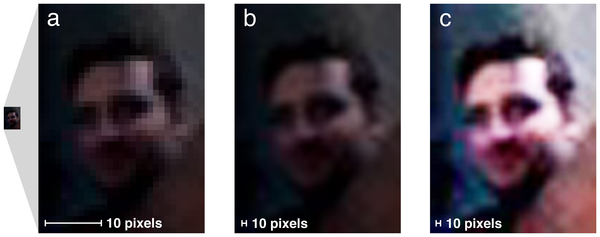Enhance! Researchers show we can now view bystanders in corneal reflections
posted Tuesday, January 6, 2015 at 4:41 PM EST

Researchers from the University of York and the University of Glasgow have published an article detailing how high-resolution photography can be used to change the landscape of criminal investigations. Specifically, the article takes a look at how images from cameras seized as evidence can provide a more detailed look at who and what was present at the scene of the crime by zooming into reflections in the eyes of the subject.
Not far off from laughable ‘enhance’ scenes, this research takes advantage of the growing trend of high-resolution cameras being more ubiquitous than ever. In particular, the article notes that crimes such as hostage taking and child sex abuse are most likely to benefit from such investigative measures as perpetrators more often photograph these crimes. There is no limit to its application though, so long as high-resolution images are available as evidence.

To test their methodology, the researchers set up two experiments, each of which fixated on a particular circumstance of the images being presented.
The first of these was a face matching task, where participants were presented with the zoomed-in image of a bystanders reflection. Of the participants who were unfamiliar with the bystanders faces, they achieved 71% accuracy when asked to later identify the individual. For those who were familiar with the subject, the rate jumped to 81%.
The second experiment was one of spontaneous recognition. This relied on participants to look over the image themselves and pull out faces they recognized. Below is a collection of the faces displayed to participants.

In both circumstances, the evidence proved overwhelmingly that this method of determining potential perpetrators is a viable solution. This is due in part to humans ability to identify faces from poor quality images; especially when they are familiar with the individuals they are trying to pick out.
The below image details how smoothing and increasing the exposure of the photograph can yield a far more detailed image. It’s by no means perfect, but more than enough to work within a criminal investigation.

This, of course, requires there to be high-resolution images present as evidence. For the image used in the two experiments, they used a photograph taken from 1 meter using a 39-megapixel digital camera, with a 120mm macro lens. A far cry from a consumer-level camera. But, as previously mentioned, technology being put into mobile phones and other portable cameras make this more and more feasible as time goes on.
For those who are interested in similar methods of using high-resolution photography as an investigative means, you might want to check out how fingerprints are now capable of being recreated using a single photograph.
(via Hacker News)